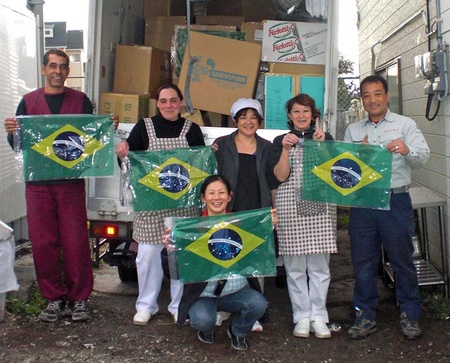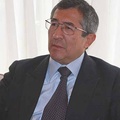"As a Japanese person, I would like to express my heartfelt gratitude." If I were to say one thing to this person, this is what I would say.
Shinji Mogi Norberto runs a company that undertakes demolition work in Fujisawa City, Kanagawa Prefecture. He couldn't sit still after watching the news reports reporting the devastation in the areas affected by the Great East Japan Earthquake on March 11, and by the end of June, he had visited the area with his fellow Japanese-Brazilians a total of five times. They used heavy machinery to remove rubble and served food such as the Brazilian meat dish churrasco... Mogi says he wants people to see Japanese-Brazilians as "people living their lives" rather than "dekasegi," but to the disaster victims, Japanese-Brazilians are already "better neighbors."
I had heard about Mogi's volunteer activities through local newspaper reports, but I heard him speak directly at a lecture entitled "Brazilians in Japan and the Great East Japan Earthquake: Efforts to Support the Disaster-stricken Areas" held at Sophia University in Shinjuku Ward, Tokyo on June 30th.

Mogi (far right) and other Japanese Brazilians rushed to the disaster area with Brazilian flags in their hands.
According to a survey by the Immigration Bureau of the Ministry of Justice, there are a total of 506 Japanese Brazilians in the affected areas, including 97 in Iwate Prefecture, 147 in Miyagi Prefecture, and 262 in Fukushima Prefecture. At the beginning of the event, Ana Elisa Yamaguchi, an assistant professor at the Faculty of Foreign Studies at Sophia University, introduced the various efforts being made by Japanese Brazilians from all over the country to support the victims, and said that the total number of Japanese Brazilians who have entered the affected areas as volunteers may be greater than the number of permanent residents in the affected areas.
Mogi-san is a Brazilian of Japanese descent who first came to Japan in 1989 and has been living here for almost 20 years. He graduated from the Department of Electronic Engineering at the University of Sao Paulo, so he is quite an elite. He started his own business shortly after arriving in Japan. He is one of the few successful people among the Japanese Brazilians, many of whom are factory workers.
The Great East Japan Earthquake of March 11th. "As a Brazilian living in Japan, I have to do something for Japan." He gathered information about the local situation, and one week later, on the 18th, he drove a truck loaded with relief supplies and heavy machinery, flying the Brazilian flag, to Ishinomaki City, Miyagi Prefecture.
In the area that was devastated by the tsunami, members of the Self-Defense Forces were using human wave tactics to clear away the rubble. There may still be survivors. They were concerned about damaging the bodies. With this in mind, the Self-Defense Forces did not use heavy machinery in their activities.
However, Mogi, who is used to handling heavy machinery in the demolition business, used small heavy machinery to clear away scrapped cars and roofs of houses. "If we attach an attachment to the end of the arm that won't break even if it pinches a beer bottle, we can do the work," Mogi said confidently. At first, the city hall put a stop to the use of heavy machinery, but he ignored the city's regulations and continued working, believing that if he got involved in bureaucratic work, he wouldn't be able to help any survivors.
The faces of the victims showed more and more fatigue with each passing day. It was clear that they were stressed. Mogi thought, "What is needed in the disaster area is human contact," and decided to go to Ishinomaki for the second and subsequent volunteering trips. After going not once, but twice or even three times, he felt that the victims were truly worried about him. He thought that his "feelings" would definitely be conveyed to the victims. He distributed relief supplies directly to those who needed them, and removed the rubble from homes where people had asked for help.
In fact, a police officer who spotted the Brazilian flag on the truck waved at him. Strangers started calling out to him, "Mr. Mogi, Mr. Mogi." An elderly man who runs a butcher shop asked him to remove the rubble from the parking lot next to his store. He asked the city hall, but was told it would take six months. The man wanted to build a temporary prefabricated store in the vacant lot of the parking lot. When he removed the rubble immediately, the man's wife was so happy that she cried, saying, "If I had waited six months, my life would have been over."
This was a time when the number of victims committing suicide began to increase. Why couldn't the government save these people?
I once went out to deliver relief supplies to an evacuation center in Minamisanriku Town. It was raining heavily outside. I heard a child scream, "Grandpa, Grandpa, run away quickly." It was as if I had a dream that my grandfather was swallowed up by the tsunami. I understood how deep the wounds in the hearts of the victims were.
When he visited Fukushima, where residents were exhausted by the nuclear accident, he was disappointed with the government's response. When he offered to hold a barbecue and serve food, he was told, "We can't do it unless you make a reservation." When he tried to donate a truckload of relief supplies, he was refused, saying, "The warehouse is full and we can't accept them." His goodwill, which seemed to be hanging in the balance, was then transported 300 kilometers by car to a certain area in Miyagi Prefecture.
Even so, the people of Tohoku generally had a positive attitude. "The power of each individual" was wonderful. "I was moved," Mogi said emphatically.
Mogi added, "In Japanese society, Japanese-Brazilians still have a negative image of being troublemakers. I am thinking about what I can do in Japan this time, and I am continuing my volunteer work with the hope of changing that."
Many Japanese Brazilians lost their jobs after the Lehman Shock in the fall of 2008, and were forced to return to their home countries. It is difficult to say that the employment situation has improved for them. At one time there were over 300,000 people, but statistics from the end of 2010 showed that their numbers had fallen to 230,000. Since March 11, the numbers have likely fallen even further. Many of those who remain have already based their lives in Japan, and are playing an important role in the multicultural society.
In an attempt to reach out to their compatriots in the aftermath of the Lehman Shock, a group of Brazilian volunteers in Japan launched the National Network of Brazilians in Japan (NNBJ). Now, a new organization called Solidarity Brazil has been created by the NNBJ, and volunteer activities are being carried out in the disaster-stricken areas with the NNBJ at its core. Mogi is one of the leaders of this organization.
Not only Brazilians in Japan, but also foreigners from Asia, Europe and America are volunteering to support and encourage those in the disaster-stricken areas. Of course, there are foreigners living in Japan among the victims. In the midst of the chaos in the disaster-stricken areas, were they able to extend a helping hand to these people who lacked Japanese language skills? This is a question that we, the Japanese people, are being asked.
*This article is reprinted from Vol. 4 of the multicultural information magazine Immigrants .
© 2011 Immigrants











